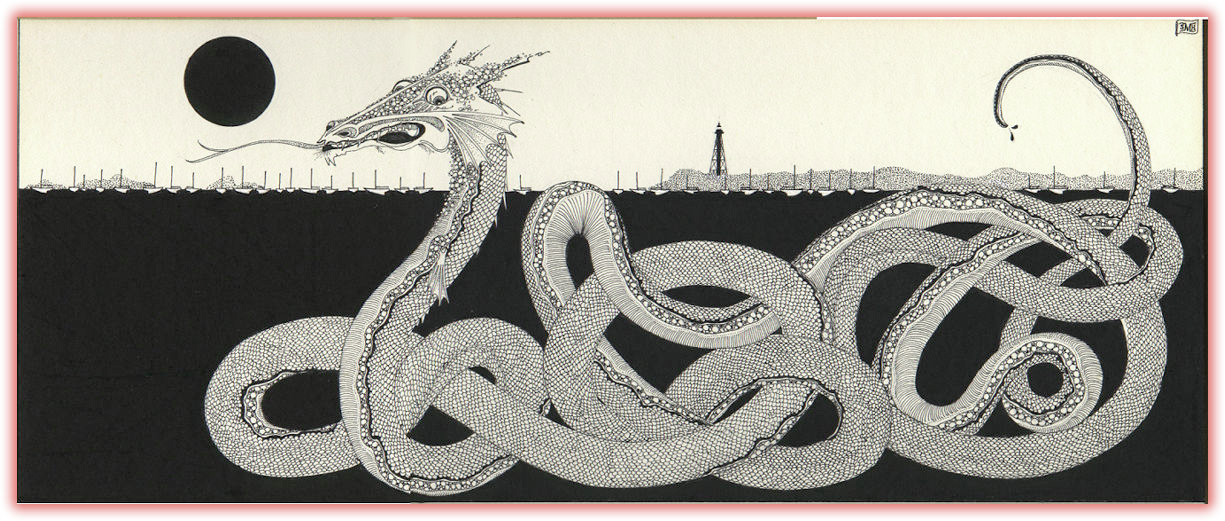|
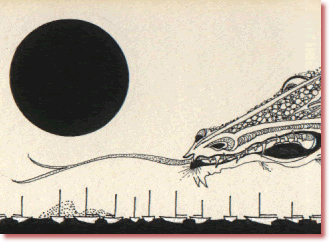 Each
summer tourists come to Marblehead to enjoy fresh seafood, swim
in the chilly Atlantic, and relax in the sun by the shore. But,
in the early 1800's, some of these pleasure-seeking travelers
got a little more than they bargained for. Each
summer tourists come to Marblehead to enjoy fresh seafood, swim
in the chilly Atlantic, and relax in the sun by the shore. But,
in the early 1800's, some of these pleasure-seeking travelers
got a little more than they bargained for.
Sea serpents have been a part of all of human history all over
the known world. The Scandinavians, Asians, and even the skeptical
British, well-known for their conservatism and reserve, have
had reports, over and over, including eye-witness testimony,
of the existence of such creatures. Sea serpents, and the myth
surrounding them, have terrified and fascinated people everywhere
since the beginning of time. Some historians have wondered: with
all of the enchanting magnetism of these stories, told in every
language, can there be, after all, any truth to them? Perhaps
the sophisticated scorn for mythologies current among today's
intellectuals has caused these stories to hide in the shadows
of modern histories, but they are still there, just as they were
in their heyday of the early 1800's.
In the age when whalers and fishermen went to sea with the same
sense of adventure and of going off into the unknown as our space
faring explorers do today, perhaps this stories of serpents and
monsters were easier to believe. The Loch Ness Monster legend
is well-known, but some of these stories are much, much closer
to home than Scotland, as a few remaining Marbleheaders, still
alive today, can well attest from Grandfathers' stories and memories.
It was during those early years when Captain John Peach had just
passed on and "Flud" Ireson was being tarred and feathered,
when the names of Marblehead's Streets were just being changed
from Ye Queen' Highway to Washington Street, and from King Street
to State Street, that a new resident took its place out in the
harbor. Not the last, nor the first, but certainly the most famous
sea serpent in our history, His Snakeship, as he was called,
the great sea serpent of Marblehead spent a memorable summer
here. The visibility, the fame which spread far and wide, and
the persistent presence here challenged all doubters, and still
does.
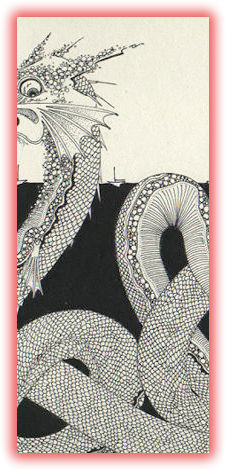
The first documented entry of a sea serpent in this area was
made by the naturalist John Josselyn, when he reported a "huge
snake" curled around the rocks of Cape Ann in 1639. For
more than a century after that there were constant reports of
such a creature and even when told by reputable and respected
people, they were scoffed at and ignored, perhaps even as you
are now doing.
In 1779, the highly-esteemed Commodore Edward Preble told of
his encounter with a serpent, which he reported to be over 150
feet long and a big around as a barrel. Even Daniel Webster witnessed
the appearance of a sea monster somewhere between Monomet and
Plymouth. But all of this was just prologue to the summer of
1817.
Apparently the rich feeding grounds and cool water of Cape Ann
and Massachusetts Bay attracted His Snakeship here for the months
of the summer, and for ten more summers after that. He was seen
by so many people of impeccable credibility and solid reputations
that their observations cannot be rationalized away. Overactive
imaginations, group hallucinations, or what was known in those
days as "a touch of the grape," may explain some things,
but they cannot hope to touch the legend of His Snakeship. Sightings
by groups of people up to over 200, often at extremely close
range have locked solidly down the fact of Marblehead's famous
sea serpent. Loch Ness Monster mover over, here comes a distant
cousin who was not illusive or impossible to find. This guy was
impossible to miss as he romped in the harbor like a seal. There
were times when no one was sure what the animal
was, but everyone was sure that is was. And, in Marblehead,
where everyone always questions everything as a strict matter
of tradition, that is saying something.
On August 2, 1817, two women watched as a sea serpent swam casually
into Cape Ann Harbor north of Gloucester roads, and nonchalantly
swam back out again, out to sea. Several fisherman confirmed
this report, and later in the week the creature was spotted again
from the shore cavorting near Ten Pound Island. On August 12
and 13, shipmaster watched as the serpent played in the water.
The written report read:
I, Solomon Allen III, of Gloucester in the county of Essex,
shipmaster, depose and say: that I have seen a strange marine
animal, that I believe to be a serpent, in the harbor in Gloucester.
I should judge him to be between eighty and ninety feet in length
and about the size of a half barrel, apparently heavy joints
from his head to his tail. ...His head formed something like
the head of a rattlesnake, but nearly as large as the skull of
a horse. When he moved on the surface of the water, his motion
was slow, at time playing around in circles, and sometimes moving
nearly straight forward. When he disappeared, he sand apparently
straight down. ...I saw him on the 12th, 13th, and 14th of August
A.D. 1817.
The next day 20 or 30 people gathered to watch the playful monster.
It seemed as though the serpent had settled in for the summer
season. He could be spotted each day acting the typical tourist
and enjoying the sun, water and seafood. But, while he did mind
his own business disturbing no one but the herring population,
the brave citizens of the area reacted to this creature in an
unfortunately typical fashion. A hue and cry was raised, and
four boats full of armed men took after the serpent. One of the
stalwarts shot the creature in the head at pointblank range.
Apparently unhurt and unperturbed by this inhospitable action,
the animal simply swam under their boats, surfaced some distance
away, and continued to amuse himself for the next several days
by investigating the shoreline.
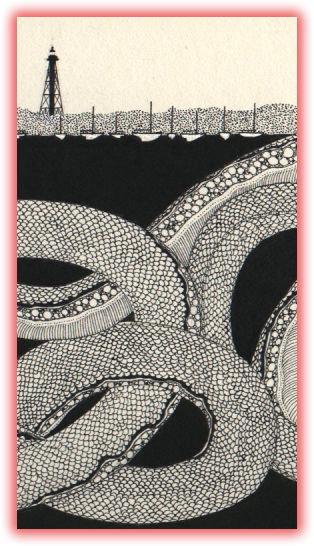
For the next week he was seen every day, and one brave soul came
within an oar's length of him. Despite being shot in the head,
beaten with oars, and followed incessantly by people in boats,
His Snakeship continued his leisurely vacation while the Linnean
Society of New England hurriedly convened around conference tables
to discuss his nature, origins and ultimate fate.
The Linnean Society, inspired by the systemic scientific methods
of the Swedish botanist Linne, formed a select committee of three
carefully-chosen members: a judge, a doctor, and a naturalist.
The committee chose the equally reputable Honorable Lonson Nash,
himself a witness to the serpent's antics, to take sworn affidavits
from the other witnesses. The committee then took under consideration
this lengthy and detailed testimony, comments from Nash, and
previous reports concerning the serpent.
From all accounts the unwelcome visitor did indeed look like
a huge snake, though his movements made it obvious that he wasn't
an ordinary snake to be sure. He had smooth dark brown, blue
or black skin with a whitish underside. Although there were reports
of the creature being up to 125 feet long, he was generally thought
to be 65 to 75 feet long. The head, held about a foot above the
surface, resembled that of a snake or a turtle, was about the
size of that of a horse, and there was a series of humps or bunches
along his back when he surfaced. The beast could move at quite
a clip, with a top speed estimated at 40 or 70 knots.
Hundreds of people saw the creature in various locations, under
different conditions, but there were no great discrepancies in
their descriptions of his appearance. Yet the Linnean Society,
disregarding obvious physical evidence to the contrary, decreed
that His Snakeship was indeed just that -- a snake, a land reptile.
In the face of this invalid conclusion, the Society lost considerable
credibility, and badly confused the record of the sea serpent,through
their report.
Nevertheless it was impossible to ignore the creature swimming
around the bay, and a reward of $5,000 for the serpent -- dead
or alive -- was posted. Whalers, sailors, and adventurers set
out in hot and noisy pursuit. At this point, either annoyed or
bored by the uproar, the monster moved to more quiet waters.
One day he was seen asleep on the surface out to sea, and for
the next 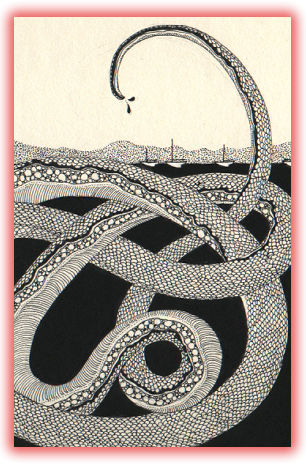 several days fishermen
encountered him miles out. By the first week of October, he'd
wandered as far as Long Island Sound. several days fishermen
encountered him miles out. By the first week of October, he'd
wandered as far as Long Island Sound.
Scientific interest in the creature continued. Of all the international
sightings of marine animals, the Massachusetts Snake was widely
accepted as the only true sea serpent. He was given the generic
name of Megophia monstrous, or big snake.
In the summer of 1818, the serpent reappeared to up summer residence
once again. He was again seen by large groups of people, and
several times, whalers came within a few yards of him to heave
harpoons. Still, the creature kept his amiable disposition, though
he did become a bit more wary.
Captain Richard Rich, a whaler, had managed to harpoon the creature
once, but the serpent shook off the weapon and escaped. Determined
to capture the animal, Captain Rich and his crew spent days hunting
for the serpent . Within a week, The Boston Advertiser
proclaimed the success of the expedition; Rich had captured the
sea-serpent! But instead of the 100-foot monster which they had
expected to find at Boston Wharf, they found a rather average-sized
tunny. Rather than admit their failure to capture the beast,
Rich and his crew had apparently played a practical joke on the
journalists.
Skeptics now felt vindicated in their opinions that there was
no such thing as a sea serpent. This slapstick conclusion to
the episode, added to the confused verdict of the Linnean Society,
seemed to discredit His Snakeship further.
However, one tuna fish wasn't about to make two summers of sightings
just disappear. The Boston Weekly Messenger noted about
the Rich case:
The fish taken by Captain Rich ... is the Tunny, or Horse
Mackerel. ... The inquiry naturally arises, can this fish, or
any number of them, be the monster so often described as a sea
serpent? We answer decidedly, no. The existence of some remarkable
animal in our waters last summer, particularly near Cape Ann,
was proved by the most satisfactory testimony, and the appearances
which he presented are not in any degree to be accounted for
by supposing any number of the fish now taken. The descriptions
which we have had this season of the 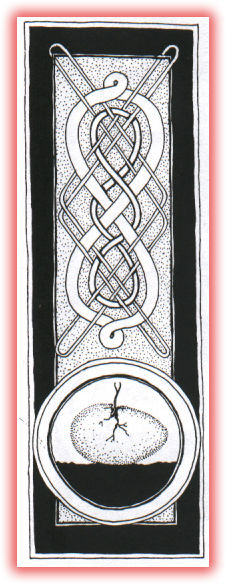 serpent
have been less consistent and satisfactory, and undoubtedly often
exaggerated. But neither these exaggerated descriptions nor the
error of persons who by mistake have been pursuing what had nothing
of the remarkable ought to lead us to suspect all former testimony. serpent
have been less consistent and satisfactory, and undoubtedly often
exaggerated. But neither these exaggerated descriptions nor the
error of persons who by mistake have been pursuing what had nothing
of the remarkable ought to lead us to suspect all former testimony.
Another editorial gave Rich credit for good intentions and
added:
But while due attention is paid to his statement, the mass
of evidence presented last year ought not to be overlooked. The
appearances described by most of the observers who have given
their testimony under oath, differ materially from those by which
Capt. Rich was deluded... Gentlemen... who had the best opportunities
of observing in the summer of 1817 and several of those whose
statements were published by the Linnean Society are still confident
that they could not have been mistaken.
Repeating quotes from reputable witnesses, the editors added,
"We leave it to our readers to conclude whether the above
testimony made deliberately on oath by men of respectability
is utterly false and groundless. If so, we should be glad to
know on what grounds human testimony is to be credited."
Meanwhile, back in the waters of Marblehead, the sea serpent
continued to spend his summers in the area. By now he was a familiar
sight and a common occurrence, even though he kept startling
people in their boats and on their moorings. In August, 1819,
the serpent was sighted off the Nahant coast, and Gershom Bradford,
A noted maritime historian and sailor reported that:
Hundreds of people congregated on the beach for a look at
a strange monster. It deserves particular attention for it was
brought under the scrutiny of Samuel Cabot, James Prince, and
James Magee, names that carried power and confidence in Boston
at that period. Their descriptions are of an animal little different
from that of the Gloucester visitor.
Nahant now evidenced some special attraction for His Snakeship,
since he appeared there every day in the summer of 1822. He wasn't
spotted around Massachusetts Bay in the summer of 1825, but he
did return in 1826.
By this time the reports of the creature were so frequent and
so uniform as to be almost monotonous.
The eminent Professor Benjamin Silliman wrote: "To us it
seems a matter of surprise that any person who has examined the
testimony can doubt the evidence of the sea serpent." Some
of the stories were undoubtedly embroidered or overblown, but
there was little doubt that some sort of creature existed. One
skeptical poet wrote:
But, go not to Nahant lest men should swear
You are a great deal bigger than you are.
In the next years, the serpent kept a low profile and wasn't
seen in the area between 1827 and 1832. But in 1833, 1834, and
1835 he was back in his old haunts, traveling as for north as
Maine and Canada. Reports now mentioned a mane, more noticeable
eyes, and, in several cases, rings near the neck.
Perhaps the area had lost its charm for the creature, as his
visits became more infrequent. He was seen in 1848, 1875, 1877
and 1879, but they were for the most part individual sightings,
and he no longer spent the entire summer lolling in the area.
Sea serpents now seem to have joined the mythical pantheon of
maritime lore. But just because he is no longer sighted, His
Snakeship may still be out there and may well appear again, just
when we least expect it. As the editor of a Boston newspaper
described the opinion of the editor of the New York Gazette:
"He gravely affects to doubt the existence of the sea monster
off our coast. Perhaps he has yet to learn that it is as much
the part of folly to doubt in the face of abundant and unquestionable
evidence as it is to listen with credulity to vague and improbable
rumors."
He is that curling serpent
That in ocean is
Sea fright he is,
And shadow under the earth.
It is never there
And already vanishing.
-- William Stanley Merwin
"Before That" (1963)
- - - - - - - - - - - - - - - - - - - - - - - - - - - - - - -
- - - - -
Dan McDougall, for many years, led, with his brother, Mike, one
of the most successful advertising agencies North Of Boston.
He is a Salem native who has always loved the sea, sailing, and
maritime legends.
Meredith Reed, assisted in the writing and editing of the original
version of this story which appeared in Marblehead Magazine in
the Summer of 1981 (Volume II, Number 2).
|




